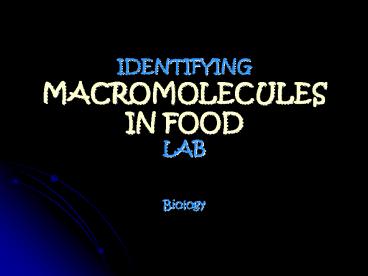IDENTIFYING MACROMOLECULES IN FOOD LAB - PowerPoint PPT Presentation
1 / 21
Title:
IDENTIFYING MACROMOLECULES IN FOOD LAB
Description:
Benedict's solution. Benedict's solution is a chemical indicator for ... Add 20 drops of Benedict solution. Place test tube in a hot water bath for 10 minutes. ... – PowerPoint PPT presentation
Number of Views:1945
Avg rating:3.0/5.0
Title: IDENTIFYING MACROMOLECULES IN FOOD LAB
1
IDENTIFYING MACROMOLECULES IN FOODLAB
- Biology
2
Introduction
- Carbohydrates, proteins, and fats are all
essential nutrients. - Our bodies cannot make these nutrients so we must
get them from what we eat.
3
- In this lab, with the use of indicators as
chemical detection tools, you will analyze a
variety of foods for the presence of nutrients. - Detection is based upon observing a chemical
change that takes place most often a change in
color.
4
Lab Objective
- Identify the presence of major nutrients such as
simple carbohydrates (glucose), complex
carbohydrates (starch), protein and fat in common
foods.
5
What is an indicator?
- Indicators are chemical compounds used to detect
the presence of other compounds.
6
Background Information
7
What is a Standard?
- An acknowledged measure of comparison for
quantitative or qualitative value a criterion.
8
Test for Simple CarbohydratesBenedicts solution
- Benedict's solution is a chemical indicator for
simple sugars such as glucose C6H12O6. - Aqua blue negative test
yellow/green/brick red, etc. positive test
9
Test for Simple CarbohydratesBenedicts solution
- Unlike some other indicators, Benedicts solution
does not work at room temperature - it must be
heated first.
10
Test for Complex CarbohydratesIodine Solution
- Iodine solution ? color change blue to black
11
Test for Complex CarbohydratesIodine solution
- Iodine solution is an indicator for a molecule
called starch. - Starch is a huge molecule made up of hundreds of
simple sugar molecules (such as glucose)
connected to each other.
12
Test for Protein (amino acids)Biuret solution
- Biuret solution ? dark violet blue to pinkish
purple
13
Test for Fats (lipids)Sudan IV
- Like lipids, the chemical Sudan IV is not soluble
in water it is, however, soluble in lipids. - In this test dark red Sudan IV is added to a
solution along with ethanol to dissolve any
possible lipids.
14
Test for Fats (lipids)Sudan IV
- If lipids are present the Sudan IV will stain
them reddish-orange (positive test).
15
Question
- Why didnt the test tube containing sucrose
change colors?
16
Question
- Why didnt the test tube containing starch change
colors?
17
ProcedureSimple carbohydrate
- Add 5ml distilled H2O using pipette
to test tube - Add 1ml of food sample to test tube
- Add 20 drops of Benedict solution
- Place test tube in a hot water bath for
10 minutes.
18
ProcedureComplex carbohydrate
- Add 5ml distilled H2O using pipette to test tube
- Add 1ml of food sample to test tube
- Add 20 drops of IKI solution
19
ProcedureProtein (amino acids)
- Add 5ml distilled H2O using pipette to test tube
- Add 1ml of food sample to test tube
- Add 20 drops of Biuret solution
20
ProcedureFats (lipids)
- Add 5ml distilled H2O using pipette to test tube
- Add 1ml of food sample to test tube
- Add 20 drops of Sudan IV
21
LAB SAFETY and CLEAN UP
NO EDIBLE products in lab
WEAR safety goggles and apron at all times
THOROUGHLY CLEAN lab area and equipment































